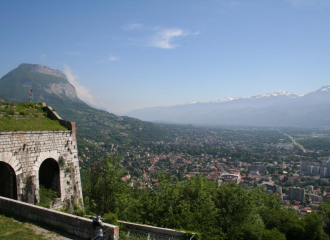Le Baptistère
Grenoble

Probably destroyed since the beginning of the 11th century because it was not mentioned in the cartulary of Bishop Saint Hugues, which listed all the episcopal properties, the baptistery had fallen into oblivion.
The quality of the conservation of these remains, and in particular the baptismal font and the paved floor, which has remained largely in its original state, has enabled us to better understand the configuration and architectural evolution of the baptistery.
In its initial configuration, dating from the end of the 4th and beginning of the 5th centuries, the Grenoble Baptistery was almost square in plan.
A white marble pavement surrounded the eight-sided, 75 cm deep baptismal font.
The sacrament of baptism was practiced by total immersion once a year, on Easter Saturday.
In the 5th century, a semi-circular apse was built on the east side.
Hundreds of coloured glass tesserae found on the site, some with gold leaf, allow us to imagine what the wall decoration might have been.
During the 6th century, three other apses were added to the walls of the baptistery, giving it its characteristic layout. The floor of these apses, covered with pink breccia tiles, is still largely preserved. The baptismal font, reduced in size and depth, becomes pentagonal. A baldachin resting on five slender columns surmounted it. The water flowed through a central hollow column and fell on the baptized. Baptism was then performed by sprinkling. The base of the central column, the lead water supply pipe and a large part of the limestone slabs around the basin are still in place.
The archaeological excavations on the site have also revealed several remains of the baptistery's side rooms. Originally the only ones authorised to administer the sacrament of baptism, the bishops delegated this role from the 7th and 8th centuries onwards to priests.
Baptisms were then performed at the baptismal font in the cathedral and the baptistery was then demolished.
From 01/01 to 31/12, daily.
Closed exceptionally on January 1st, May 1st and December 25th.
Free of charge.
Contact et accès 2 rue Très-Cloîtres38000 Grenoble
Isère (38)
Informations complémentaires
Ça peut vous intéresser

Atelier Fabrique Kids : Lampe Halloween

The Bastille and Saint-Eynard forts

Escalade avec CORDEO

Restaurant du Téléphérique

Piscine Intercommunale du Néron

Canyoning avec Cordeo

Bureau des Guides et Accompagnateurs de Grenoble

Canyoning et Grimpe d’arbre avec In Canyon We Trust

Via ferrata avec le Bureau des guides et accompagnateurs de Grenoble

Canyoning proche de Grenoble avec Vertical Aventure

EVA – Esports Virtual Arenas







